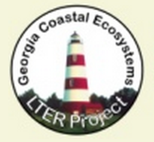Project: Georgia Coastal Ecosystems Long Term Ecological Research site
Description
Adapted (2015) from http://gce-lter.marsci.uga.edu/
Site description: The Georgia Coastal Ecosystems Long Term Ecological Research site (GCE) was established by the National Science Foundation in 2000. The study domain encompasses three adjacent sounds (Altamaha, Doboy, Sapelo) on the coast of Georgia, U.S.A., and includes upland (mainland, barrier islands, marsh hammocks), intertidal (fresh, brackish and salt marsh) and submerged (river, estuary, continental shelf) habitats.
Patterns and processes in this complex landscape vary spatially within and between sites, and temporally on multiple scales (tidal, diurnal, seasonal, and inter-annual). Overlain on this spatial and temporal variation are long-term trends caused by climate change, sea level rise, and human alterations of the landscape. These long-term trends are likely to manifest in many ways, including changes in water quality, river discharge, runoff and tidal inundation patterns throughout the estuarine landscape.
Research Context: Over the coming decades, the Georgia coast is expected to experience substantial changes due to factors such as climate change, sea level rise, and human alterations of the landscape that will cause transitions in dominant habitat types (state changes) within the GCE domain by changing the amounts and patterns of water delivery across the landscape. The overarching goal of the GCE LTER is to understand the mechanisms by which variation in the quality, source and amount of both fresh and salt water create temporal and spatial variability in estuarine habitats and processes, in order to predict directional changes that will occur in response to long-term shifts in estuarine salinity patterns.
Program Information: The GCE field site is based at the University of Georgia Marine Institute on Sapelo Island, and the program is administered at the University of Georgia Department of Marine Sciences in Athens, Georgia. Over 60 participants, representing 14 academic institutions and agencies, are currently involved in GCE research and educational programs. The GCE Information Management System (see the Data URL above) provides online access to hundreds of core data sets, ancillary data sets from partner agencies, a searchable document and imagery archive, and a searchable bibliography of over 1400 publications from 50 years of research on the Georgia coast and Sapelo Island.
LTER Data: The Georgia Coastal Ecosystem (GCE) LTER data are managed by and available directly from the GCE project data site URL shown above. If there are any datasets listed below, they are data sets that were collected at or near the GCE LTER sampling locations, and funded by NSF OCE as ancillary projects related to the GCE LTER core research themes.
This project is supported by continuing grants with slight name variations:
- LTER - Georgia Land/Ocean Margin Ecosystem
- LTER: Georgia Coastal Ecosystems-II
- LTER: Georgia Coastal Ecosystems-III
| Dataset | Latest Version Date | Current State |
|---|---|---|
| Environmental data, nitrifier abundance, ammonia oxidation rates from six from R/V Savannah cruises in the South Atlantic Bight in 2014 (GCE-LTER) | 2017-04-26 | Final no updates expected |

People
Principal Investigator: Merryl Alber
University of Georgia (UGA)
Co-Principal Investigator: Steven Pennings
University of Houston
Contact: Merryl Alber
University of Georgia (UGA)
Programs
Long Term Ecological Research network [LTER]
